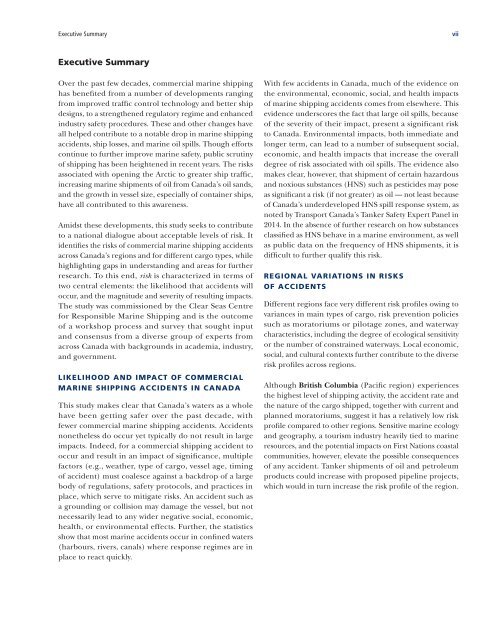Commercial Marine Shipping Accidents Understanding Risks Canada
cca_marine_shipping_risks_en_fullreport
cca_marine_shipping_risks_en_fullreport
Create successful ePaper yourself
Turn your PDF publications into a flip-book with our unique Google optimized e-Paper software.
Executive Summary<br />
vii<br />
Executive Summary<br />
Over the past few decades, commercial marine shipping<br />
has benefited from a number of developments ranging<br />
from improved traffic control technology and better ship<br />
designs, to a strengthened regulatory regime and enhanced<br />
industry safety procedures. These and other changes have<br />
all helped contribute to a notable drop in marine shipping<br />
accidents, ship losses, and marine oil spills. Though efforts<br />
continue to further improve marine safety, public scrutiny<br />
of shipping has been heightened in recent years. The risks<br />
associated with opening the Arctic to greater ship traffic,<br />
increasing marine shipments of oil from <strong>Canada</strong>’s oil sands,<br />
and the growth in vessel size, especially of container ships,<br />
have all contributed to this awareness.<br />
Amidst these developments, this study seeks to contribute<br />
to a national dialogue about acceptable levels of risk. It<br />
identifies the risks of commercial marine shipping accidents<br />
across <strong>Canada</strong>’s regions and for different cargo types, while<br />
highlighting gaps in understanding and areas for further<br />
research. To this end, risk is characterized in terms of<br />
two central elements: the likelihood that accidents will<br />
occur, and the magnitude and severity of resulting impacts.<br />
The study was commissioned by the Clear Seas Centre<br />
for Responsible <strong>Marine</strong> <strong>Shipping</strong> and is the outcome<br />
of a workshop process and survey that sought input<br />
and consensus from a diverse group of experts from<br />
across <strong>Canada</strong> with backgrounds in academia, industry,<br />
and government.<br />
LIKELIHOOD AND IMPACT OF COMMERCIAL<br />
MARINE SHIPPING ACCIDENTS IN CANADA<br />
This study makes clear that <strong>Canada</strong>’s waters as a whole<br />
have been getting safer over the past decade, with<br />
fewer commercial marine shipping accidents. <strong>Accidents</strong><br />
nonetheless do occur yet typically do not result in large<br />
impacts. Indeed, for a commercial shipping accident to<br />
occur and result in an impact of significance, multiple<br />
factors (e.g., weather, type of cargo, vessel age, timing<br />
of accident) must coalesce against a backdrop of a large<br />
body of regulations, safety protocols, and practices in<br />
place, which serve to mitigate risks. An accident such as<br />
a grounding or collision may damage the vessel, but not<br />
necessarily lead to any wider negative social, economic,<br />
health, or environmental effects. Further, the statistics<br />
show that most marine accidents occur in confined waters<br />
(harbours, rivers, canals) where response regimes are in<br />
place to react quickly.<br />
With few accidents in <strong>Canada</strong>, much of the evidence on<br />
the environmental, economic, social, and health impacts<br />
of marine shipping accidents comes from elsewhere. This<br />
evidence underscores the fact that large oil spills, because<br />
of the severity of their impact, present a significant risk<br />
to <strong>Canada</strong>. Environmental impacts, both immediate and<br />
longer term, can lead to a number of subsequent social,<br />
economic, and health impacts that increase the overall<br />
degree of risk associated with oil spills. The evidence also<br />
makes clear, however, that shipment of certain hazardous<br />
and noxious substances (HNS) such as pesticides may pose<br />
as significant a risk (if not greater) as oil — not least because<br />
of <strong>Canada</strong>’s underdeveloped HNS spill response system, as<br />
noted by Transport <strong>Canada</strong>’s Tanker Safety Expert Panel in<br />
2014. In the absence of further research on how substances<br />
classified as HNS behave in a marine environment, as well<br />
as public data on the frequency of HNS shipments, it is<br />
difficult to further qualify this risk.<br />
REGIONAL VARIATIONS IN RISKS<br />
OF ACCIDENTS<br />
Different regions face very different risk profiles owing to<br />
variances in main types of cargo, risk prevention policies<br />
such as moratoriums or pilotage zones, and waterway<br />
characteristics, including the degree of ecological sensitivity<br />
or the number of constrained waterways. Local economic,<br />
social, and cultural contexts further contribute to the diverse<br />
risk profiles across regions.<br />
Although British Columbia (Pacific region) experiences<br />
the highest level of shipping activity, the accident rate and<br />
the nature of the cargo shipped, together with current and<br />
planned moratoriums, suggest it has a relatively low risk<br />
profile compared to other regions. Sensitive marine ecology<br />
and geography, a tourism industry heavily tied to marine<br />
resources, and the potential impacts on First Nations coastal<br />
communities, however, elevate the possible consequences<br />
of any accident. Tanker shipments of oil and petroleum<br />
products could increase with proposed pipeline projects,<br />
which would in turn increase the risk profile of the region.


